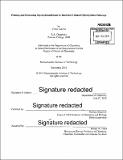Priming and processing glycosyltransferases in bacterial N-linked glycosylation pathways
Author(s)
Lukose, Vinita
DownloadFull printable version (25.00Mb)
Other Contributors
Massachusetts Institute of Technology. Department of Chemistry.
Terms of use
Metadata
Show full item recordAbstract
Bacterial cell surfaces prominently feature a variety of complex glycoconjugates. Although these structures are very diverse, the biosynthesis of these glycoconjugates shares common themes. In particular, a priming glycosyltransferase or phosphoglycosyltransferase (PGT) initiates the biosynthesis of glycans by transferring a Cl'-phosphosugar onto a polyprenol phosphate substrate. The membrane-bound polyprenol diphosphosugar product is then further elaborated by additional glycosyltransferases, flipped across the inner bacterial membrane, and ultimately used as glycosyl donor substrate in transfer to a final acceptor substrate, which, is a lipid, a protein or another glycan. This thesis focuses on the priming GTs that catalyze the first step in glycoconjugate biosynthesis. This class of enzymes is structurally diverse and includes several distinct families of enzymes with different structures and membrane topologies. PglC, the smallest and structurally, the simplest PGT found in Campylobacter jejuni, represents a tractable model with which to investigate this class of enzymes. First, efforts to structurally characterize PglC are discussed, with a focus on the challenges associated with expressing, purifying and characterizing integral membrane proteins. The next section of this thesis presents the functional characterization of PglC using a variety of biochemical techniques. In addition, bioinformatics analysis of PglC and related PGT families was employed to provide insight into critical residues required for catalytic activity. To complement this, a predicted structure of PgIC was developed, based on the wealth of information contained in the sequences of homologs of PglC. Kinetic analysis of PglC was used to investigate the mechanism of the PGT reaction. Together, these studies aided in the design and evaluation of inhibitors of PgIC, inspired by the nucleoside antibiotics tunicamycin and mureidomycin. In the final chapter, the enzymes in the N-linked protein glycosylation pathway in Campylobacter jejuni were evaluated for their tolerance for azide-modified UDP-sugar substrates. In vitro experiments were employed to investigate the potential of these enzymes for executing the chemoenzymatic synthesis of the C. jejuni glycan with azide-modified sugars at discrete targeted positions. Attempts to metabolically label C. jejuni with azide-modified sugars for in vivo incorporation into the N-glycan are also presented.
Description
Thesis: Ph. D., Massachusetts Institute of Technology, Department of Chemistry, 2015. Cataloged from PDF version of thesis. Includes bibliographical references.
Date issued
2015Department
Massachusetts Institute of Technology. Department of ChemistryPublisher
Massachusetts Institute of Technology
Keywords
Chemistry.